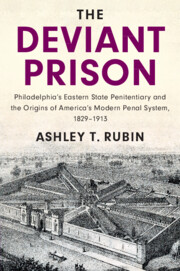 The Deviant Prison
The Deviant Prison from Part II - THE ADVANTAGE OF DIFFERENCE: The Process of Institutionalization
Published online by Cambridge University Press: 12 January 2021
This chapter examines two strategies Eastern's administrators used in their annual reports to challenge one of the most effective—and personally detrimental—myths: the Pennsylvania System’s cruelty and inhumanity. To undermine this myth, Eastern's administrators used several techniques of neutralization, characterizing the Pennsylvania System and themselves as a kind, benevolent, and humane, while arguing that the Auburn System’s supporters were the opposite—profit mongers willing to resort to cruel practices. These techniques allowed the administrators to defend themselves against charges that they were engaging in cruel and inhumane behavior. Because of their defensive posture the administrators could sublimate their own self-praise into the prison’s defense. Thus, administrators' statements defending the Pennsylvania System were often as much about the administrators themselves as the system they sought to defend. Indeed, the ability to constantly issue these statements incentivized Eastern's administrators to maintain the Pennsylvania System for as long as they did. These claims were the largest anchor keeping the Pennsylvania System personally institutionalized.
To save this book to your Kindle, first ensure [email protected] is added to your Approved Personal Document E-mail List under your Personal Document Settings on the Manage Your Content and Devices page of your Amazon account. Then enter the ‘name’ part of your Kindle email address below. Find out more about saving to your Kindle.
Note you can select to save to either the @free.kindle.com or @kindle.com variations. ‘@free.kindle.com’ emails are free but can only be saved to your device when it is connected to wi-fi. ‘@kindle.com’ emails can be delivered even when you are not connected to wi-fi, but note that service fees apply.
Find out more about the Kindle Personal Document Service.
To save content items to your account, please confirm that you agree to abide by our usage policies. If this is the first time you use this feature, you will be asked to authorise Cambridge Core to connect with your account. Find out more about saving content to Dropbox.
To save content items to your account, please confirm that you agree to abide by our usage policies. If this is the first time you use this feature, you will be asked to authorise Cambridge Core to connect with your account. Find out more about saving content to Google Drive.